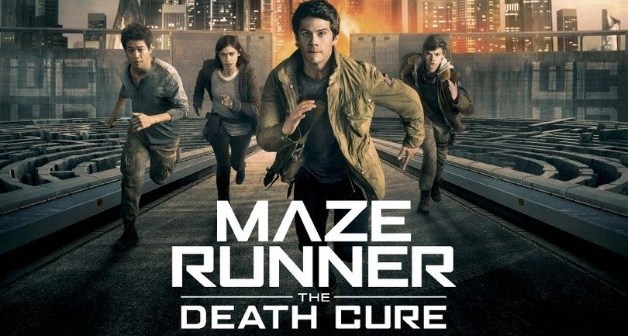by Bob Garver
“Maze Runner: The Death Cure” really missed out on the “YA book series set in a dystopian future” bandwagon. That trend essentially ended when “The Hunger Games” went out with a relative whimper in 2015. Or maybe it was when the third “Divergent” movie bombed so horribly in 2016 that the fourth movie was postponed indefinitely. This movie would have been considered a pathetic straggler if it had opened in 2016 or 2017 like it was supposed to, and then star Dylan O’Brien suffered an injury that severely delayed production. I didn’t see a lot of love for the “Maze Runner” franchise at that point, and it’s not like it was ever on the level of “Hunger Games” or even “Divergent” anyway, so I thought I’d never have to see this movie. But it seems as though a persisting love for the genre, paired with a shrewd January opening (something has to take down “Jumanji” after a month on top) has led to this film being a bigger hit than I expected. And you know what, that’s not a bad thing.
The movie sees Thomas (O’Brien) and his band of fellow survivors trying to rescue a friend (Ki Hong Lee) who had been kidnapped by the WCKD Corporation. WCKD is trying to eradicate a disease that’s wiping out humanity, but is doing so by torturing their subjects and killing those who oppose their methods, leading to an ethical dilemma. The corporation is headed by Dr. Paige (Patricia Clarkson), who has the fiendish Janson (Aiden Gillen) as her head of security. Also working for WCKD is scientist Theresa (Kaya Scodelario), Thomas’s former love interest, who betrayed her friends in the last movie for what she considered the greater good. To be honest, I had forgotten all about Teresa’s betrayal in the three years since the last movie, just like I had forgotten about half the characters in this series. The overlong break did this movie no favors in the “who stands where with who” department.
Thomas forms a shaky alliance with a resistance movement led by a noseless disease-sufferer (Walton Goggins), which includes a former enemy long thought dead. Thomas thinks the group opposes WCKD, but they actually oppose everyone who lives inside a cushy quarantine zone. This leads to an impressive city destruction sequence. Actually, most of the sequences in this movie are pretty impressive, more so than in previous installments. My theory is that the extra time gave the filmmakers more of a chance to polish the film. It looks less rushed than if its team had been in a hurry to spit out the film before the YA craze died out.
That extra layer of professionalism makes “Maze Runner: The Death Cure” the best of the “Maze Runner” movies. Unfortunately, that’s not saying much. I still can’t bring myself to care about most of these characters, especially Thomas. Dr. Paige is right when she says that he needs to see the bigger picture beyond just saving his friends. WCKD could develop a cure based on his immunities in about a minute if he’d just cooperate. Even the vile Janson turns into a softie for a moment when he thinks a treatment has been developed that can stave off the disease in children. Imagine the hope and peace it could bring to the nicer characters. I think the problem was naming the company WCKD, it makes them look more evil than they really are. Maybe the disease wiped out the PR division that would have pointed that out. The franchise at least avoids the pitfall of splitting its final installment into two half-baked movies, but the trade-off is that this movie takes forever at 142 minutes. We’re currently in the midst of awards season and “Paddington 2” is still in theaters, so this movie shouldn’t be your highest priority, but it does bring the inferior “Maze Runner” series to a surprisingly competent conclusion.
Grade: C
“Maze Runner: The Death Cure” is rated PG-13 for intense sequences of sci-fi violence and action, language and some thematic elements. Its running time is 142 minutes.
Contact Bob Garver at rrg251@nyu.edu.





